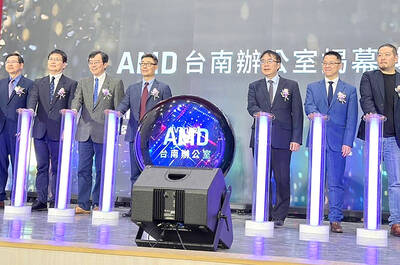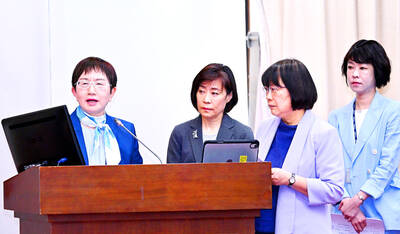China’s yuan strengthened, touching a 17-year high, on speculation the central bank will allow the currency to appreciate as part of measures to contain the fastest inflation in more than two years.
The People’s Bank of China increased the amount of cash lenders are required to set aside as reserves by half a percentage point effective on Thursday, it said on its Web site yesterday, pushing the requirement to a record 20.5 percent for the biggest banks.
China will continue tightening monetary policy for “some time,” central bank Governor Zhou Xiao-chuan (周小川) said on Sunday, a day after the nation reported -inflation that was the quickest since July 2008.
“The country will focus more on non-interest-rate measures, including more reserve-ratio hikes to drain cash domestically and faster currency appreciation to contain imported inflation,” said Dariusz Kowalczyk, a Hong Kong-based economist at Credit Agricole CIB.
He expects at least one more reserve-ratio increase this year to 21 percent.
The yuan climbed 0.06 percent to 6.5287 per US dollar as of the 4:30pm close in Shanghai yesterday, according to the China Foreign Exchange Trade System. The currency touched 6.5276 earlier, the strongest level since the -country unified official and market exchange rates at the end of 1993. In Hong Kong’s offshore market, the yuan gained 0.02 percent to 6.5215.
The People’s Bank of China set the currency’s reference rate 0.01 percent weaker at 6.5310. The fixing was 6.5301 on Friday, the strongest level since July 2005.
Twelve-month non-deliverable forwards declined 0.02 percent to 6.3830 per US dollar, reflecting bets the yuan will strengthen 2.3 percent in a year from the onshore spot rate, according to data compiled by Bloomberg. The contracts reached 6.3615 on April 8, the highest level since the same month in 2008.
China’s economy expanded 9.7 percent from a year earlier in the first quarter and consumer prices rose 5.4 percent last month, the National Bureau of Statistics of China said on Friday. Economists expected growth of 9.4 percent and a 5.2 percent inflation rate, based on median estimates in Bloomberg surveys.
Asia’s largest economy has room to raise interest rates and banks’ reserve-requirement ratios this year as the country faces difficulties achieving the 4 percent goal for consumer price increases this year, the China Securities Journal said in a front-page editorial yesterday. The yuan may continue to gain appropriately, the editorial said.
The nation’s third interest-rate increase this year may come as soon as next month and policy makers may consider allowing faster appreciation of the yuan to reduce the cost of imported commodities such as oil, according to Societe Generale SA. A flexible yuan will become a very effective tool for curbing inflation, the China Business News reported yesterday, citing former US Treasury secretary Henry Paulson.

TECH CLUSTER: The US company’s new office is in the Shalun Smart Green Energy Science City, a new AI industry base and cybersecurity hub in southern Taiwan US chip designer Advanced Micro Devices Inc (AMD) yesterday launched an office in Tainan’s Gueiren District (歸仁), marking a significant milestone in the development of southern Taiwan’s artificial intelligence (AI) industry, the Tainan City Government said in a statement. AMD Taiwan general manager Vincent Chern (陳民皓) presided over the opening ceremony for the company’s new office at the Shalun Smart Green Energy Science City (沙崙智慧綠能科學城), a new AI industry base and cybersecurity hub in southern Taiwan. Facilities in the new office include an information processing center, and a research and development (R&D) center, the Tainan Economic Development Bureau said. The Ministry

ADVERSARIES: The new list includes 11 entities in China and one in Taiwan, which is a local branch of Chinese cloud computing firm Inspur Group The US added dozens of entities to a trade blacklist on Tuesday, the US Department of Commerce said, in part to disrupt Beijing’s artificial intelligence (AI) and advanced computing capabilities. The action affects 80 entities from countries including China, the United Arab Emirates and Iran, with the commerce department citing their “activities contrary to US national security and foreign policy.” Those added to the “entity list” are restricted from obtaining US items and technologies without government authorization. “We will not allow adversaries to exploit American technology to bolster their own militaries and threaten American lives,” US Secretary of Commerce Howard Lutnick said. The entities

Minister of Finance Chuang Tsui-yun (莊翠雲) yesterday told lawmakers that she “would not speculate,” but a “response plan” has been prepared in case Taiwan is targeted by US President Donald Trump’s reciprocal tariffs, which are to be announced on Wednesday next week. The Trump administration, including US Secretary of the Treasury Scott Bessent, has said that much of the proposed reciprocal tariffs would focus on the 15 countries that have the highest trade surpluses with the US. Bessent has referred to those countries as the “dirty 15,” but has not named them. Last year, Taiwan’s US$73.9 billion trade surplus with the US

The Taipei International Cycle Show (Taipei Cycle) yesterday opened at the Taipei Nangang Exhibition Center, with the event’s organizer expecting a steady recovery in the industry this year following a tough last year. This year, 980 companies from 35 countries are participating in the annual bicycle trade show, showcasing technological breakthroughs and market development trends of the bicycle industry at 3,600 booths, the Taiwan External Trade Development Council (TAITRA, 外貿協會) said in a statement. Under the theme “Ride the Revolution,” the exhibition has attracted more than 3,500 international buyers from 80 countries to preregister for the four-day event, which is expected to